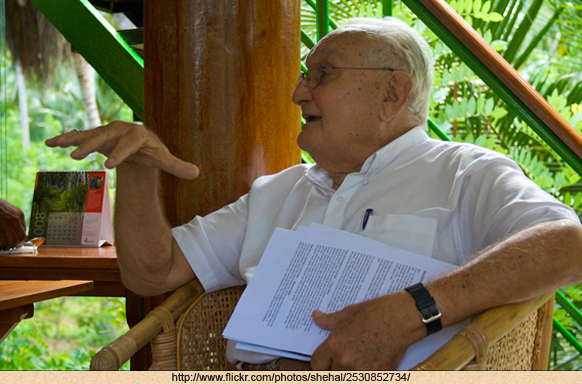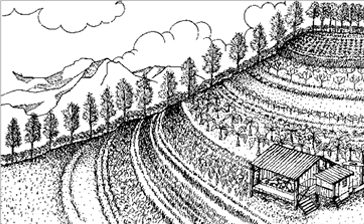Caring for the Land: SALT
 |
During the 1970s, Ray Wijewardene worked for the UN Food and Agriculture Organisation (FAO) in Kuala Lumpur, Malaysia, and for the International Institute of Tropical Agriculture (IITA) in Ibadan, Nigeria. In numerous interactions with small farmers across Africa and Asia, he realized that a fundamental requirement in tropical farming was never to expose the soil to the elements – rain, flowing water or wind. It should always be shaded by trees or foliage.
To achieve this in hilly areas, he started promoting a technique called Sloping Agricultural Land Technology (SALT), which prevents soil erosion while also rejuvenating the soil. Originally developed in the Philippines in the early 1970s, SALT involves planting fast-growing, nitrogen-fixing (leguminous) plants on the contours of hills. These grow to form double hedgerows, typically five metres apart. Between these, the branches are regularly lopped, spread and allowed to turn into mulch. The mulch enriches the soil with nitrogen and also retains moisture, while the hedgerow roots prevent the fertile topsoil from being washed or swept away.
 Ray experimented with the SALT concept to customise it for different soil and climatic conditions in Africa and Asia. For example, he introduced perennial trees into SALT-farmed lands; it had been a traditional practice in rain-fed farming in Sri Lanka for centuries.
Ray experimented with the SALT concept to customise it for different soil and climatic conditions in Africa and Asia. For example, he introduced perennial trees into SALT-farmed lands; it had been a traditional practice in rain-fed farming in Sri Lanka for centuries.
Returning to Sri Lanka in the 1980s, he promoted SALT in the country’s central hill country which is especially prone to heavy soil erosion. In this, he worked first with the tobacco, and then tea plantation companies. As an honorary advisor to the Ceylon Tobacco Company (CTC), he guided tobacco out-growers on adopting SALT to improve their hitherto rudimentary soil conservation practices.
He recommended Gliricidia sepium – a central American plant – to be grown on the contours. Gliricidia was locally known in Sri Lanka by various names as Ginisiriya, Wetahiriya, Wetamara, Ladappa, Nanchi, Sevana, Makulatha and Albesia. It grew fast, and fixed nitrogen from the air. Farmers could use leaves and branches as both mulch and fertilizer.
Beginning in 1989, the SALT experiments were carried out in Dadayampola, a rural hamlet near Hanguranketa in the Uda-Dumbara region. Three years later, there was a noticeable build-up of the soil. Besides tobacco, farmers started growing coffee, pepper, bananas and maize. CTC devised ways of propagating Gliricidia and distributing it to farmers, some of who lived in locations with no road access. The company also paid them an incentive.
Success at Dadayampola, earlier a barren area, convinced other upcountry farmers: for them, seeing was believing! Within a few years, all the hill country tobacco lands were converted to SALT. Later, many tea plantation companies also adopted the same method. Ray’s appointment in 1989 as Chairman of the Tea Research Board strengthened collaboration with the tea industry.
 SALT was nothing new... It was what our own Department of Agriculture had recommended half a century ago. But sadly, it became neglected under the fervour to adopt high-external-input technologies funded from the temperate regions of the world. SALT was nothing new... It was what our own Department of Agriculture had recommended half a century ago. But sadly, it became neglected under the fervour to adopt high-external-input technologies funded from the temperate regions of the world. - Ray Wijewardene |
Ray’s SALT-led soil conservation work was recognised both nationally and internationally. For example, in 1997, CTC won the prestigious Worldaware Award for Sustainable Development in the UK for its pioneering work with SALT and tobacco farmers in Sri Lanka. Indian tea plantations have emulated their Sri Lankan counterparts in adopting SALT.
Ray continued to experiment with tropical farming, sustainable land care and renewable energy. In the 2000s, he introduced dendro thermal power, a method that burns fast-growing trees like Gliricidia and Tithonia (local name: ‘Wal Suriyakantha’) to generate electricity. In 2005, the government designated Gliricidia as the fourth plantation crop in Sri Lanka, after tea, rubber and coconut.
For more insights, read:
![]() Fresh paradigm for a permanent truce with Nature by Ray Wijewardene, Daily News, 29 October 2007
Fresh paradigm for a permanent truce with Nature by Ray Wijewardene, Daily News, 29 October 2007
Who speaks for small farmers, earthworms and cow dung? Interview with Nalaka Gunawardene, Groundviews, 19 August 2010

